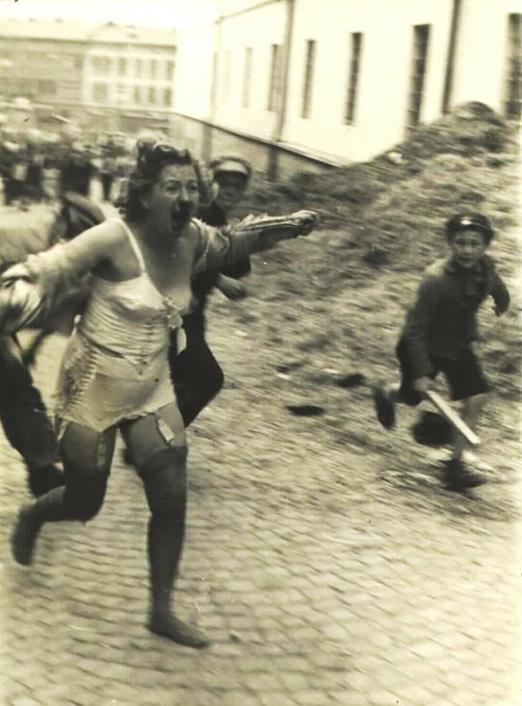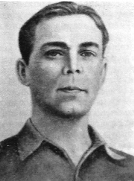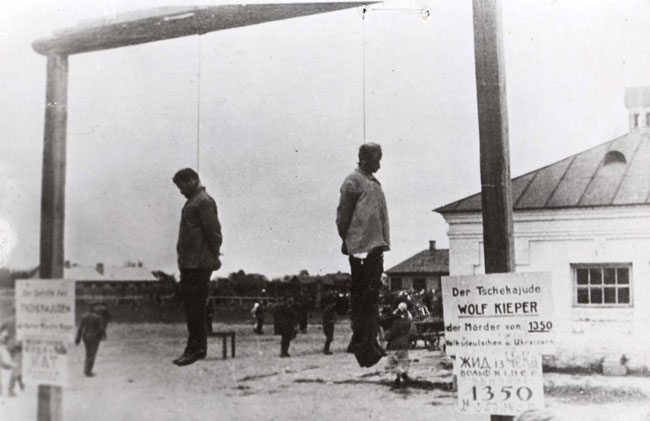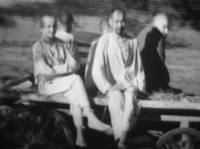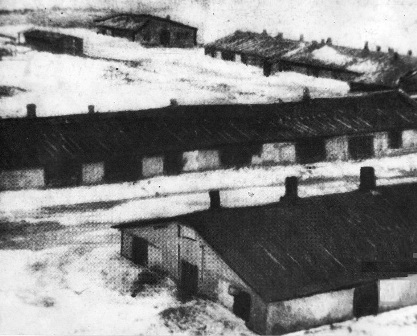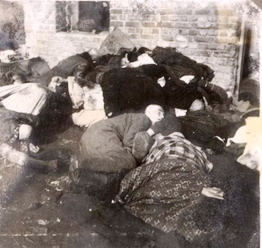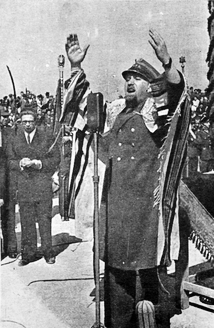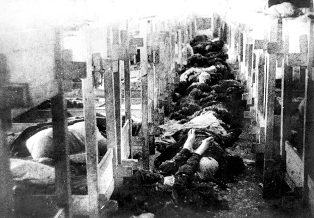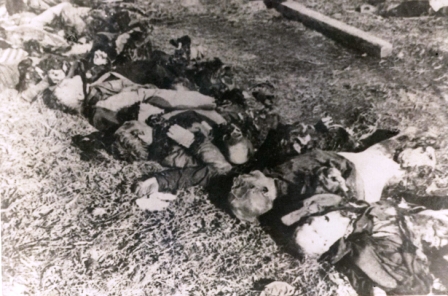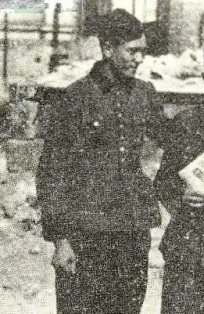Holocaust Education & Archive Research Team |
|
Occupation German Occupation of Europe Timeline
-
[The Occupied Nations]
Poland Austria Belgium Bulgaria Denmark France Germany Greece Hungary Italy Luxembourg The Netherlands Norway Romania Slovakia Soviet Union Sudetenland | ||||||
The Holocaust in the Soviet Union and Baltic States Eyewitness Statements - 1941 -1943
Tadeusz Zaderecki a Polish writer who lived in Lvov recalled:
A rabble of drunken farmers flowed in from the countryside in Lvov. Something was about to happen and it was planned. The prisons that the Soviets left behind opened and dozens, hundreds of mutilated bodies of political prisoners were revealed.
Who carried out the murders? The Jews! The fact that the murdered included Jews made no difference to anyone. In front of the military prison, Zamarstinov, hundreds of Jews were removed from the nearby houses ,men,women, old people, youngsters,boys and girls,children, all naked, after their clothes and underwear had been plucked from them, bleeding, followed by blows and kicks into the prison courtyard.
The people were ordered to dig their own pits and trenches, into which they fell, after being shot. Some three hundred people were killed on that day, and several thousands more were injured, beaten, crippled.
Thus is the face of the first day of German rule in Lvov
Andreas Eberl a German soldier watched an Aktion in the Latvian town of Daugavpils:
We heard that they were executing Jews in the prison – we went to watch. The executions didn’t take place inside the prison but nearby.
The trenches were two and a half meters wide and 40 to 50 long. I couldn’t work out the depth of the trench, since it contained the bodies of hundreds of Jews who had been shot earlier.
The condemned were forced to kneel on their knees on a dirt bank, with their faces towards the trench. The commandos shot them in the back of the neck. The distance between the shooter and the person being shot was about half a meter.
After being shot the people fell off the bank and into the trench. The commando unit consisted of ten men, half of them shot, while the other half stood behind them and changed places from time to time.
Inside the pit, I could see a man of about sixty, obviously a Jew whose job it was to arrange the bodies in rows. When a row of corpses was completed, the man climbed out of the pit and sprinkled white stuff, probably chlorine, over the corpses.
For about an hour, I watched the executions along with my friends. During that time, some 150 Jews were shot. The number of soldiers watching was about 60 to 80.
The Jews who were shot and fell into the pit and continued to move were shot with a sub-machine gun by one of the commandos. Ammunition for recharging the weapons was laid on a table alongside some bottles of vodka, and from time to time, one of the commandos would come up and take a sip from the bottle.
Vsevelod Klokov interviewed on The World at War – historical TV series:
The occupiers were harsh, very harsh, especially in those areas where the partisans were active. In the Ukraine 511 villages were burnt down by the Nazis, before the population could escape.
In one village Pinsk near Kiev, which was totally raised to the ground, babies were thrown into the fire.
Anton Heidborn a soldier with Sonderkommano 4a that took part in the infamous massacre at Babi Yar, Kiew where 33,771 Jews were executed on the 29 and 30 September 1941:
The third day after the execution we were taken back to the execution area. On our arrival we saw a woman sitting by a bush who had apparently survived the execution unscathed.
This woman was shot by the SD man who was accompanying us. I do not know his name. We also saw someone waving their hand from among the pile of bodies. I don’t know whether it was a man or a woman. I should think that this person was finished off by the SD man as well, though I did not actually see it.
The same day work began to cover up the piles of bodies. Civilians were used for this task. The ravine walls were also partly blown up. After that day I never returned to the execution area.
The next few days were spent smoothing out banknotes belonging to the Jews that had been shot. I estimate these must have totalled millions. I do not know what happened to the money. It was packed up in sacks and sent off somewhere.
Anton Lauer Police Reserve Battalion 9 made a statement regarding the use of gas vans:
There were two gas-vans in use. I saw them myself. They were driven into the prison yard and the Jews – men, women and children – had to get into the van directly from the cell.
I also saw inside the gas-vans, they were lined with metal and there was a wooden grille on the floor. The exhaust gases were fed into the inside of the van.
I can still today hear the Jews knocking and shouting, “Dear Germans, let us out.
Heinrich Huhn, a member of Sonderkommando 4a recalls a public hanging in Zhitomir:
I can remember that the Jewish functionary Kieper and his aide fell into the hands of Sonderkommando 4a. Who tracked down these men I no longer know. I think that Dr Boss, who was working with us, had something to do with it.
Blobel gave orders that both were to be hanged publically in the market-place in Zhitomir. The Whermacht, our unit and the civilian population were notified. On the day of the hanging the entire unit marched to the market- place in closed formation. Some of our truck –drivers had erected a gallows there.
Before the hanging Unterturmfuhrer Muller gave a speech in Ukrainian to the big crowd of civilians gathered there. In front of the gallows sat a largish crowd of Jews huddled together. These Jews had to keep their hands above their heads and watch the proceedings.
I do not know whether the Jews were made to say anything during the execution. If I am challenged with the witness Jordan’s statement that the Jews had to say, “We want to go to the Promised Land,” I cannot tell you if this was true.
After the hanging the Jews were shot outside Zhitomir at the so-called Pferdfriedhof (horse cemetery).
Albert Bronowski, manager of the Rumbuli railway station near Riga, Lativa, witnessed the murder of thousands of Jews:
The executions began on the morning of November 30. The people were naked, except for a shirt and underpants and carrying their children in their arms.
German soldiers stood next to the trench and next to them were boxes into which the people were to place the last objects of value that they had with them, watches, rings, necklaces
From the trench came the incessant sound of gunfire and rounds from automatic weapons. The few who tried to burst through the guards in order to save their lives were shot by the soldiers on guard.
Dr Albert Widman participated in a test gassing carried out by Arthur Nebe, commander of Einstazgruppen B, in Nowinki, near Mogilev, on mental patients:
Nebe ordered the window bricked in, leaving two openings for the gas hose. When we arrived, one of the hoses I had brought was connected. It was fixed onto the exhaust of a reconnaissance car.
Pieces of piping stuck out of the holes made in the wall, onto which the hose could easily be fitted. After five minutes, Nebe, came out and said that nothing appeared to have happened.
Nebe and I reached the conclusion that the car’s engine wasn’t strong enough. So Nebe had the second hose fitted onto a truck belonging to the Orpo. It then took only another few minutes before the people were unconscious.
Karl Jager commander of Einsatzkommando 3 testified at his trial:
On arriving in Kaunus I found there the Lithuanian police, whose existence was authorised by the German authorities. Commander of the Lithuanian Sipo was Stasis Cenkus.
Also there was what they called an Erschiessungskommando , or shooting unit, consisting of 50 -100 Lithuanians under the command of the Lithuanian Lieutenant Bronius Norkus. He and his unit were under the command of Obersturmfuhrer Joachim Hamann, together with whom they carried out shooting operations against the Jews.
Haim Baram, was deported from Berlin to Minsk described the deportation:
On November 14 at 8:00 in the evening the train started moving. We don’t know where we are being taken to. November 18 the train stopped, Minsk is before us.
At about 3:00 all the doors are opened at once and a wild mob of Latvian SS burst in. People, women and children are thrown brutally out of the train.... blows and kicks.
We didn’t understand what was wanted of us.... in the end we arrived at a special fenced in ghetto.
The Gebietskommissar of Slonim, Gerhard Erren, wrote a report on the actions of Einsatzkommando 8:
When I arrived at the Slonim area, there were some 25,000, of whom 16,000 lived in Slonim proper – two thirds of the town’s population.
The action carried out by the Sipo on November 13 1941, has freed me of the unnecessary guzzlers. The 7,000 remaining Jews in Slonim have entered the labour process, and are doing it willingly, out of a constant fear of death. For the time being, the countryside has undergone large scale cleansing by the army. Unfortunately, this has been done only in towns with less than 1,000 inhabitants.
V.Y. Tatakovskaya a Jewish woman from Dnepropetrovsk married to a Russian, escaped from an Aktion later recalled:
All the Jews were ordered to gather by the Lux store. It was told that this was being done to organise a ghetto. I collected a few things and went with my two children to the store. There we were formed into a column and led away.
When we passed the Jewish cemetery and came to the empty lot next to the railroad, we heard shooting. It was at this point that we realised why we had been brought here.
A crowd of several thousand people ... then they started forcing us toward the pits at the end of the lot and everywhere screams,shots and the cries of children.
S. Krivoruchko a Jewish engineer in Kharkov testified about life and death in the ghetto:
For many of the elderly and the handicapped, the journey from the city to the barracks of the tractor factory was the last of their lives. In the room in which I found myself, more than seventy people had arrived by evening, whereas no more than six to eight people would be able to live in it.
Some twenty to thirty people a day were dying from hunger, we were also suffering from a lack of water. Fortunately for us, there was a snowfall and we used the snow instead of water. From the dreadful overcrowding, hunger and lack of water, an epidemic of gastrointestinal diseases broke out.
We were permitted to go out of the barracks between 8 a.m. and 4 p.m. – anyone who went out at any other time was shot on the spot. By morning, the corridors of the barracks were befouled to an unimaginable degree. Then there began a cleanup by hand, since there were no shovels or brooms, and the Germans threatened us with the firing squad if it wasn’t all picked up within an hour. The morning was also the time for removing the bodies of those who had died the night before.
On January 2, 1942 at 7 a.m. in the barrack where I was staying, a German sentry shouted out an order for everyone to gather their things and be outside in ten minutes.
The German sentries and policemen formed a tight ring around us and announced that we were being evacuated to Poltava. We marched out onto the Chuguyev- Kharkov highway, but then we were directed away from the city, although the road to Poltava ran through town.
Two kilometres past the last houses of the tractor factory workers’ quarters, they turned us in the direction of a ravine from which we heard occasional shots and the chattering of machine guns.
Savoika Starna a partisan fighter in Golubaia – Dacha remembered:
A youth arrived at the ghetto from Vitebsk, telling that in Vitebsk all the Jews had been shot. Members of the Jewish council caught him and asked; “Why are you spreading rumours and causing panic? Why are you lying?”
People did not believe that they would be killed. It was possible to escape, but there was nowhere to escape to, there were still no partisans. Most people’s logic was ”if we run away – they’ll kill us, if we stay- maybe we’ll manage to survive.”
Yosef Weingartner from Kerch survived a murder action, near the village of Bagrowo, approximately 4 kilometres west of Kerch testified:
We were brought to the prison – toward evening, the commander of the prison arrived, “Citizens, there is no reason to be upset.... tomorrow we’ll take you to collective farms to work.” The people calmed down.
The next morning five trucks drove to the prison – great was the shoving and pushing, the people wanted to get out of the prison as soon as possible and find freedom in the collective farms.
The trucks kept coming back for new passengers all day. That night, someone remarked that it was strange that the truck needed only twenty-five minutes for a round trip. Where could they take the people in such a short period?
This was such a startling thought that we were all seized by horror, we spent a miserable night. In the morning the trucks came again, I sensed that something was wrong as soon as we left the town.
Before I managed to think things over, I saw a mountain of clothing and the anti-tank trenches. We found ourselves surrounded by soldiers pointing rifles at us.
They began to herd us toward the pit, directly toward the bodies of the people, at that moment shots rang out, I said goodbye to my wife. As we stood embracing each other, a bullet struck her in the head and her blood spurted in my face.
I lay unconscious for a long time, suddenly I opened my eyes and saw the stars gleaming... I crawled out of the pit and set out in a random direction.
Rabbi Kahane recalls the deportations of Jews from Lvov to the Belzec death camp in 1942:
The action began two weeks before Passover. They kidnapped anyone who didn’t have a work permit. Night after night the Sobieski school was filled with miserable people, and when it was packed tight, the Gestapo moved the people to the railway station, loaded them on trucks, and the trains set off.
Where to? For the time being, no one knows.
The action has been going on for a week now, but the work of the Jewish police has not been good enough for the Gestapo.
Tadeusz Zaderecki described the August 1942 deportations from Lvov, to Belzec;
They surrounded house after house, the sick were shot in their beds. People jumped from the top storeys in order to hasten their deaths and avoid being tortured. Jews were forced out of rooftop hiding places with poles and fell to their deaths to become a stain of blood on the side walk.
On August 12 notices signed by General Katzmann were posted in the town, threatening death to anyone caught harbouring Jews or extending any kind of assistance to them. This warning also said that anyone knowing the whereabouts of Jews had to inform the police and would be punished for refraining to do so and an incentive was promised.
As a prize Jewish property would fall into the hands of anyone informing on them. The bait worked, and betrayals flowed in. The Jews were given away by the rabble as well as by the so-called educated classes, whether for material gain or out of fear.
From among the intelligentsia there came few informants. These made do with refusing to continue harbouring Jews and turning them out of their homes, but there were also those who chose to ignore the Germans’ threats – Jews found hiding were shot on the spot.
Every transport to arrive at Janowska camp underwent a selection. Young physically fit men were sent to the labour camps. The others were made to undress and loaded on railway trucks, destined for the crematoria at Belzec. They were loaded naked in order to prevent attempted escapes.
M. Balberiszsky who was interned at the Klooga camp in Estonia wrote:
It was already afternoon, and the workers were not returning. Suddenly there was a sound of automatic rifle fire. Every fifteen minutes, Germans came and took away 25 to 50 people and immediately afterwards there was the sound of rifle fire.
Twilight – the courtyard gradually emptied, at a certain moment a group of people got away, I was among them, to a nearby building, and hid under the beds. We’re lying there, listening and waiting. Will the murderers enter?
Suddenly the dark hall is lit up by a sea of lights. Tongues of fire rise to the skies.... what’s happening? What is the meaning of the flames?
Suddenly there is quiet, silence, only fire and sparks, Children, women, men are burned in the fire and when day breaks once again we no longer see any Germans.
Paul Blobel the commander of the Sonderkommando 1005, which was charged with erasing the traces of mass murder in the east testified:
In May and June 1943, I visited Kiev. Following talks with Dr Thomas and SS and Police Leader Hennecke, the mission went into operation.
Because of the advancing front, it was impossible to destroy the mass graves that were located at a greater distance. Later Gruppenfuhrer Muller sent me to Estonia. I passed on the same order to Oberfuhrer Achamer Pifrader in Riga, as well to Obergruppenfuhrer Jeckeln.
Blobel personally reviewed the progress of Sonderkommando 1005 in Kiev in August 1943, and Ziama Trubakov, a Jewish inmate from the nearby Syretsk camp later testified:
On August 18 1943, I was brought to Babi Yar ..... Two prisoners stood there and tied chains to our legs. Some of the prisoners were taken to the Jewish cemetery, and from there they took headstones and iron fences.
They used the headstones and fences to create a 10 meter by 10 meter raised platform, with air vents underneath. Afterwards, the platform was covered with alternate layers of bodies and wooden planks and gasoline was poured over the pile of bodies and wood.
Between 2,000 and 2,500 bodies were laid on each such platform. They were set on fire. We spread the ashes over the nearby fields. A prisoner named Rapoport and I were forced to examine the bodies, to remove gold and other valuables.
I was there until September 28, 1943, until the escape. During that period I was witness to the burning of more than 125,000 corpses.
Adolf Riba, a German who was in charge of the prisoners in Sonderkommando 1005 Mitte at Maly-Trostinets testified to events there during November 1943:
At 15.00 Harder, who was in charge of erasing evidence, came to me....
Into the pile of bodies and wood planks which had reached a height of about 2 meters, Harder inserted an upright pole. As he was busy doing this, two trucks arrived from Minsk together with Dr Heuser, who came in his car.
In the trucks were about 10 SS men from Minsk and about 30 Jewish men and women. The Jews were ordered to get off the truck. Twenty of them were taken by Dr. Heuser and the SS men who came with him to an open pit nearby and shot.
The 8 to 10 remaining Jews were ordered to undress and their wrists and ankles were bound by ropes. The naked, bound Jews, of whom there were more women than men, were dragged by the SS men from Minsk and raised via a ladder to the top of the pile, where they were laid.
Harder, who was standing at the top of the pile, tied one of the female Jews to the upright pole and then descended from the pile and set them on fire. Before that, they poured gasoline on the Jews.
As the pile was burning, the Jewess who had been tied to the upright pole suddenly jumped down. The rope which had been used to tie her had probably burned away. She was caught immediately by the commando people from Minsk and placed back on the top of the pile.
Notwithstanding the flame, the murderer went back up on the pile and retied the Jewish woman to the upright pole. The Jews who were being burned alive emitted horrific cries as the flames consumed them.
The Jewish Prisoner of War Yuri Farber in January 1944 was taken to Panerai, near Vilnius and employed in burning corpses, he testified:
Our task was to burn 800 corpses a day. The Trager (porters) carried the bodies to the wooden pyre. There the figures were piled up in rows one on top of the other. When one layer was stacked, spruce branches were put on top.
A pyramid was considered ready when it contained 3,500 corpses, a pyramid usually burned for three days. The men were mostly from Vilnius, and there was not one of them who did not find his family among the corpses.
There were several religious men in the pit. From time to time, they would organise requiems in honour of the dead. The services were conducted solemnly and mournfully.
The Sturmfuhrer was a threat and a terror. Whenever he appeared at the edge of the pit, everyone knew that no good would come of it. The Sturmfuhrer would stand there looking at us and then say to someone, “Why are you walking so slowly?” Are you sick?” The man would answer that he was well. But the Sturmfuhrer said to him, “Tomorrow you’ll go to the infirmary.”
Everyone knew that this meant he would be shot. ... to be continued
Sources:
The Holocaust in the Soviet Union by Yitzhak Arad, published by the University of Nebraska Press and Yad Vashem 2009 Those Were The Days by Ernst Klee, Willi Dressen, Volker Riess, published by Hamish Hamilton,London 1991 World at War – Historical TV Series – Thames Television 1973 Imperial War Museum (IWM) London Holocaust Historical Society Yad Vashem
Copyright Chris Webb, Carmelo Lisciotto, and Victor Smart H.E.A.R.T 2012
|
